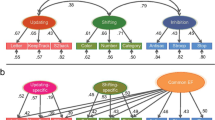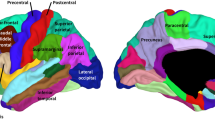Abstract
We compared the brain structure of highly proficient simultaneous (two languages from birth) and sequential (second language after age 5) bilinguals, who differed only in their degree of native-like accent, to determine how the brain develops when a skill is acquired from birth versus later in life. For the simultaneous bilinguals, gray matter density was increased in the left putamen, as well as in the left posterior insula, right dorsolateral prefrontal cortex, and left and right occipital cortex. For the sequential bilinguals, gray matter density was increased in the bilateral premotor cortex. Sequential bilinguals with better accents also showed greater gray matter density in the left putamen, and in several additional brain regions important for sensorimotor integration and speech–motor control. Our findings suggest that second language learning results in enhanced brain structure of specific brain areas, which depends on whether two languages are learned simultaneously or sequentially, and on the extent to which native-like proficiency is acquired.


Similar content being viewed by others
References
Abutalebi J, Della Rosa PA, Gonzaga AK, Keim R, Costa A, Perani D (2013) The role of the left putamen in multilingual language production. Brain Lang 125(3):307–313
Ad-Dab’bagh Y, Einarson D, Lyttelton O, Muehlboeck J-S, Mok K, Ivanov O, Vincent RD, Lepage C, Lerch J, Fombonne E, Evans AC (2006) The CIVET image-processing environment: a fully automated comprehensive pipeline for anatomical neuroimaging research. In: Corbetta M (ed) Proceedings of the 12th annual meeting of the organization for human brain mapping. NeuroImage, Florence. http://www.bic.mni.mcgill.ca/users/yaddab/Yasser-HBM2006-Poster.pdf
Berken JA, Gracco VL, Chen J-K, Watkins KE, Baum SM, Callahan M, Klein D (2015) Neural activation in speech production and reading aloud in native and non-native languages. NeuroImage 112:208–217
Bermudez P, Lerch JP, Evans AC, Zatorre RJ (2008) Neuroanatomical correlates of musicianship as revealed by cortical thickness and voxel-based morphometry. Cereb Cortex 19:1583–1596
Boersma P (2001) Praat, a system for doing phonetics by computer. Glot Int 5(9/10):341–345
Booth JR, Mehdiratta N, Burman DD, Bitan T (2008) Developmental increases in effective connectivity to brain regions involved in phonological processing during tasks with orthographic demands. Brain Res 1189:78–89
Buckley KA, Tobey EA (2011) Cross-modal plasticity and speech perception in pre- and postlingually deaf cochlear implant users. Ear Hear 32(1):2–15. doi:10.1097/AUD.0b013e3181e8534c
Cobb T (2009) The compleat lexical tutor. http://www.lextutor.ca. Accessed 18 Sep 2012
Christophe A, Guasti T, Nespor M, Dupoux E, Van Ooyen B (1997) Reflections on phonological bootstrapping: its role for lexical and syntactic acquisition. Lang Cogn Proc 12:585–612. doi:10.1080/016909697386637
Collins DL, Neelin P, Peters TM, Evans AC (1994) Automatic 3D intersubject registration of MR volumetric data in standardized Talairach space. J Comput Assist Tomogr 18:192–205
Collins D, Holmes C, Peters T, Evans AC (1995) Automatic 3D model-based neuroanatomical segmentation. Hum Brain Mapp 3(3):190–208
Dayan E, Cohen LG (2011) Neuroplasticity subserving motor skill learning. Neuron 72:443–454
Draganski B, Draganski B, Gaser C, Busch V, Schuierer G, Bogdahn U, May A (2004) Neuroplasticity: changes in grey matter induced by training. Nature 427(6972):311–312
Flege JE, Munro MJ, MacKay IRA (1995) Factors affecting strength of perceived foreign accent in a second language. J Acoust Soc Am 97:3125–3134
Fonov V, Evan AC, Botteron K, Almli CR, McKinstry RC, Collins DL, Brain Development Cooperative Group (2011) Unbiased average age-appropriate atlases for pediatric studies. NeuroImage 54(1):313–327
Frenck-Mestre C, Anton JL, Roth M, Vaid J, Viallet F (2005) Articulation in early and late bilinguals’ two languages: evidence from functional magnetic resonance imaging. NeuroReport 7:761–765
Gaser C, Schlaug G (2003) Gray matter differences between musicians and nonmusicians. Ann N Y Acad Sci 999:514–517
Gerber P, Schlaffke L, Heba S, Greenlee MW, Schultz T, Schmidt-Wilcke T (2014) Juggling revisited: a voxel-based morphometry study with expert jugglers. NeuroImage 95:320–325
Giraud AL, Lee HJ (2007) Predicting cochlear implant outcome from brain organisation in the deaf. Restor Neurol Neurosci 25:381–390
Golestani N, Pallier C (2007) Anatomical correlates of foreign speech sound production. Cereb Cortex 17(4):929–934
Golestani N, Zatorre RJ (2004) Learning new sounds of speech: reallocation of neural substrates. NeuroImage 21(2):494–506
Golestani N, Molko N, Dehaene S, LeBihan D, Pallier C (2007) Brain structure predicts learning of foreign speech sounds. Cereb Cortex 17(3):575–582
Goswami U (2008) The development of reading across languages. Ann N Y Acad Sci 1145:1–12
Green DW (1998) Mental control of the bilingual lexico-semantic system. Biling Lang Cognit 1:67–81
He Q et al (2013) Decoding the neuroanatomic basis of reading ability. J Neurosci 33(31):12835–12843
Hernandez AE, Li P (2007) Age of acquisition: its neural and computational mechanisms. Psychol Bull 133(4):638–650
Hervais-Adelman AG, Moser-Mercer B, Golestani N (2011) Executive control of language in the bilingual brain: integrating the evidence from neuroimaging to neuropsychology. Front Psychol 2:234. doi:10.3389/fpsyg.2011.00234 (eCollection 2011)
Hyde K, Lerch J, Norton A, Forgeard M, Winner E, Evans AC, Schlaug G (2009) Musical training shapes structural brain development. J Neurosci 29(10):3019–3025
Johnson JS, Newport EL (1989) Critical period effects in second language learning: the influence of maturational state on the acquisition of English as a second language. Cogn Psychol 21(1):60–99
Klein D, Zatorre RJ, Milner B, Meyer E, Evans AC (1994) Left putaminal activation when speaking a second language: evidence from PET. NeuroReport 5:2295–2297
Klein D, Milner B, Zatorre RJ, Meyer E, Evans AC (1995) The neural substrates underlying word generation: a bilingual functional-imaging study. Proc Natl Acad Sci USA 92(7):2899–2903
Klein D, Watkins KE, Zatorre RJ, Milner B (2006) Word and nonword repetition in bilingual subjects: a PET study. Hum Brain Mapp 27:153–161
Kuhl PK (2010) Brain mechanisms in early language acquisition. Neuron 65(7):713–727
Kurowski KM, Blumstein SE, Alexander M (1996) The foreign accent syndrome: a reconsideration. Brain Lang 54(1):1–25
Luk G, Bialystok E, Craik FI, Grady CL (2011) Lifelong bilingualism maintains white matter integrity in older adults. J Neurosci 31(46):16808–16813
Maguire EA, Woollett K, Spiers HJ (2006) London taxi drivers and bus drivers: a structural MRI and neuropsychological analysis. Hippocampus 16(12):1091–1101
Marchand WR, Lee JN, Thatcher JW, Hsu EW, Rashkin E, Suchy Y, Chelune G, Starr J, Barbera SS (2008) Putamen coactivation during motor task execution. NeuroReport 19(9):957–960
Marian V (2007) The Language Experience and Proficiency Questionnaire (LEAP-Q): assessing language profiles in bilinguals and multilinguals. J Speech Lang Hear Res 50(4):940–967
Mechelli A, Crinion JT, Noppeney U, O’Doherty J, Ashburner J, Frackowiak RS, Price CJ (2004) Neurolinguistics: structural plasticity in the bilingual brain. Nature 431:757
Moyer A (2007) Empirical consideration on the age factor in L2 phonology. Issues Appl Ling 15(2):109–127
Penfield W, Roberts L (1959) speech and brain mechanisms. Athenaeum, New York
Postuma RB, Dagher A (2006) Basal ganglia functional connectivity based on a metaz-analysis of 126 positron emission tomography and functional magnetic resonance imaging publications. Cereb Cortex 16(10):1508–1521
Radua J, Canales-Rodriguez ES, Pomerol-Clotet E, Salvador R (2014) Validity of modulation and optimal setting for advanced voxel-based morphometry. NeuroImage 86:81–90
Reiterer SM, Hu X, Erb M, Rota G, Nardo D, Grodd W, Winkler S, Ackermann H (2011) Individual differences in audio-vocal speech imitation aptitude in late bilinguals: functional neuro-imaging and brain morphology. Front Psychol 2:271. doi:10.3389/fpsyg.2011.00271 (eCollection 2011)
Ressel V, Pallier C, Ventura-Campos N, Díaz B, Roessler A, Ávila C, Sebastián-Gallés N (2012) An effect of bilingualism on the auditory cortex. J Neurosci 32(47):16597–16601
Saur D, Baumgaertner A, Moehring A, Büchel C, Bonnesen M, Rose M, Musso M, Meisel JM (2009) Word order processing in the bilingual brain. Neuropsycholgia 47(1):158–168
Schlaffke L, Lissek S, Lenz M, Brüne M, Juckel G, Hinrichs T, Platen P, Tegenthoff M, Schmidt-Wilcke T (2014) Sports and brain morphology—a voxel-based morphometry study with endurance athletes and martial arts. Neuroscience 259:35–42
Schön D, Magne C, Besson M (2004) The music of speech: music training facilitates pitch in both music and language. Psychophysiology 41(3):3410349
Shum M, Shiller DM, Baum SR, Gracco VL (2011) Sensorimotor integration for speech motor learning involves the inferior parietal cortex. Eur J Neurosci 34(11):1817–1822
Sled JG, Zijdenbos AP, Evans AC (1998) A nonparametric method for automatic correction of intensity nonuniformity in MRI data. ICEE Trans Med Imaging 17(1):87–97
Sowell ER, Thompson PM, Toga AW (2004) Mapping changes in the human cortex throughout the span of life. Neuroscientist 10(4):372–392
Talairach J, Tournoux P (1988) Co-planar stereotaxic atlas of the human brain. Thieme Medical, New York
Wartenburger I, Heekeren HR, Abutalebi J, Cappa SF, Villringer A, Perani D (2003) Early setting of grammatical processing in the bilingual brain. Neuron 37(1):159–170
Weber-Fox CM, Neville HJ (1996) Maturational constraints on functional specializations for language processing: ERP and behavioral evidence in bilingual speakers. J Cogn Neurosci 8(3):231–236
Wechsler D (1981) Manual for the Wechsler Adult Intelligence Scale—revised. The Psychological Corporation, San Antonio
Werker JF, Tees RC (1984) Phonemic and phonetic factors in adult cross-language speech perception. J Acoust Soc Am 75(6):1867–1878
Worsley KJ, Marrett S, Neelin P, Vandal AC, Friston KJ, Evans AC (1996) A unified statistical approach for determining significant signals in images of cerebral activation. Hum Brain Mapp 4(1):58–73
Zatorre RJ (2013) Predispositions and plasticity in music and speech learning: neural correlates and implications. Science 342(6158):585–589
Acknowledgments
Jennifer Soles assisted with the experimental setup and subject recruitment. Megan Callahan assisted with the quantitative language assessment. The study was supported by funds from the Blema and Arnold Steinberg Family Foundation and grants from the Natural Sciences and Engineering Research Council of Canada (NSERC) to D. Klein and V. Gracco, the Social Sciences and Humanities Research Council of Canada (SSHRC) to Baum, Gracco, and Klein, and a Vanier Canada Doctoral Scholarship to J. Berken (NSERC).
Author information
Authors and Affiliations
Corresponding author
Ethics declarations
Conflict of interest
The authors declare no competing financial interests.
Rights and permissions
About this article
Cite this article
Berken, J.A., Gracco, V.L., Chen, JK. et al. The timing of language learning shapes brain structure associated with articulation. Brain Struct Funct 221, 3591–3600 (2016). https://doi.org/10.1007/s00429-015-1121-9
Received:
Accepted:
Published:
Issue Date:
DOI: https://doi.org/10.1007/s00429-015-1121-9




